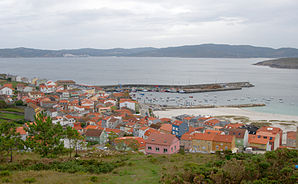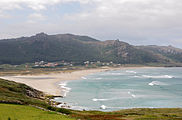Lax
| Laxe municipality | ||
|---|---|---|
 Lax
|
||
| coat of arms | Map of Spain | |

|
|
|
| Basic data | ||
| Autonomous Community : |
|
|
| Province : | A Coruña | |
| Comarca : | Bergantiños | |
| Coordinates | 43 ° 13 ′ N , 9 ° 0 ′ W | |
| Area : | 36.78 km² | |
| Residents : | 3,016 (Jan 1, 2019) | |
| Population density : | 82 inhabitants / km² | |
| Postal code : | 15317 | |
| Municipality number ( INE ): | 15040 | |
| Nearest airport : | A Coruña | |
| administration | ||
| Official language : | Castilian , Galician | |
| Mayor : | Antón Carracedo Sacedón (PSdeG- PSOE ) | |
| Website : | www.concellodelaxe.com | |
Laxe ( Galician ) or Lage ( Spanish ) is a seaside resort and port on the Costa da Morte in Galicia .
Geographical location
Laxe is located at the western end of the Bergantiños , protected in the south-western corner of the wide bay Ría de Corme e Laxe . Opposite him, in the northeast corner of the bay, is Corme . The rougher coastal strip west of the village belongs to the municipality and merges with the small town of Camelle in the coastal section of the municipality of Camariñas ; however, a narrow strip of territory in the municipality of Vimianzo separates Laxe from Camariñas. Other neighboring communities are Zas and Cabana de Bergantiños .
With 36.78 km² Laxe is one of the smallest municipalities in the province of A Coruña .
Word meaning
The Galician laxe comes from the high medieval lagena . This word of Celtic origin means stone or rock slab.
history

Until the beginning of the 19th century, Laxe, along with Camariñas and a considerable part of Zas and Muxía , was subject to the jurisdiction of Vimianzo in the then province of Santiago de Compostela.
After the Knights Templar collapsed, King Henry II gave this area to the aristocratic Mariño family. On September 15, 1425, Don Frederic, Duke of Arjona and Count of Trastámara , gave the area as a dowry to his cousin Juana de Castro for her wedding to Don Rodrigo de Moscoso. Thus Laxe passed into the possession of the noble Moscoso family.
When the four provinces of Galicia were established in the 19th century, Laxe was assigned to the province of A Coruña and placed under the jurisdiction of Carballo . Laxe was thus part of the Bergantiños and independent of the Moscoso family.
coat of arms
The municipal coat of arms shows a tower surrounded by seven stars under a crown. It is said to go back to a banner of Don Abente Chans, a person with a certain significance for the community history and ancestor of the geologist Isidro Parga Pondal.
Sub-municipalities
Laxe consists of the following parroquias :
- Laxe (Santa María)
- Nande (San Simón)
- Sarces (San Amedio)
- Serantes (Santa María)
- Soesto (Santo Estevo)
- Traba (Santiago)
Population development of the municipality
economy
The main sources of income for the population are fishing, ports, agriculture and tourism.
Fishing had its heyday in the middle of the 20th century when a large fleet of fishing cutters was in operation on site. In addition to coastal fishing, which is still important, sea shipping of wood and structural steel plays a major role. In addition, tuna landed. The port of Laxe is the only one on the Costa da Morte, where in the recent past both the catches, the shipments and the number of employees have increased.
Tourism has also increased significantly in the recent past. The quayside is lined with a number of restaurants, pubs and bars.
Attractions
Churches
Santa María da Atalaia
The Church of Santa María da Atalaia was built in the 13th century. Atalaia means watch: the church stands on a hill above the harbor, its location offers an overview of the place, the harbor and far over the bay. This allowed the residents to look out for attackers and whales. Whaling was an important source of income on the Costa da Morte until the 19th century.
Five bells once rang in the massive tower at the south-east corner of the church; since 1868 there are only two left. On the southern flank, an outside staircase with three Gothic relief sculptures leads through a gate to a gallery above the altar. The three sculptures from the 15th century show St. Anne with little Maria , a Franciscan and an angel.
With its massive structure, the church is laid out in the Romanesque style; in the course of its construction it developed into the marine Gothic style typical of the area . The latter can be seen, for example, in the archways and in the cross vaults in the interior. On the north side there is a gate, which was probably built in the beginning of the 16th century. On the medieval high altar there is a representation of the Virgin Mary , a frieze with five scenes of the resurrection of Christ and a Christ as ruler of the world from the 14th century. There are more pictures from the 17th and 18th centuries above various side altars.
Santiago de Traba
Santiago de Traba was built between the 13th and 18th centuries. The rectangular nave, the square, vaulted apse and the rear windows, the buttresses of the south wall and the cornices are Romanesque . A renovation in the Baroque period is evident in the form of the large altarpiece , which even reveals echoes of the Rococo . The facade is also designed in the form of a baroque altarpiece. Flanked by winding columns, there is a representation of Santiago Matamoros in the tympanum : St. James as a fighter on horseback, a slain enemy under horseback. Above him there is a statue of the Mother of God and above this a relief bust of God the Father . On the sides of the door there are statues of Adam and Eve , above them the hll. Peter and Francis . A bell tower with two open round arches crowns the facade.
Santa Rosa de Lima
The chapel of St. Rosa von Lima lies high above the town on Monte Cornaceiras. In 1676 a seafarer named Couceiro had worshiped St. Rosa had a stone cross erected there: the Cruz do Navegante ("Navigator's Cross"). It stands at the foot of the chapel, which was built in 1941 and dedicated to the patronage of the saints. Coudeiro was on the route Spain - Peru . The long stretch through the Atlantic, around Cape Horn and along the coast of South America was dangerous in and of itself and was made unsafe by pirates. In the event of a happy return, Couceiro promised to erect a cross for the Peruvian saint and to bring some of her relics with him from Peru. Inside the church, models of boats hang from the ceiling: votive offerings from seafarers, as can often be found in Galician churches.
coast
There are four beaches in the area of Laxe, all of them with fine, white sand that meet different needs:
- The Praia de Laxe falls relatively flat into the water; Additionally protected by the long pier, there is hardly any surf and is well suited for families with small children.
- The Praia de Soeste in the neighboring bay is exposed to the open ocean to the northwest. At the parking lot in the uninhabited bay, surfers camp with their minibuses and mobile homes.
- The Praia de Arnado , only around 100 m wide, crouches between rocks. Around 4 km from the village, it can only be reached on foot. It offers a good spot to get into the water for divers who want to snorkel between the rocks in calmer weather.
- Even more open than Praia de Soeste is Praia de Traba, 8 km from the village and more than two kilometers long . Surfers who love an even stronger surf cavort here. The long beach, little frequented in the middle section, is also suitable for an extended beach hike with its dunes, swamps and lagoon landscape behind.
An approximately 8 km long coastal hiking trail leads from Laxe to Traba. From the center of the village, the Rúa Santa Rosa leads in an east-southeast direction up the mountain to the Col de Castro . Above to the left, the Santa Rosa chapel invites you to take a detour. From the top of the pass it goes down to Praia de Soeste. A boardwalk with a cord railing leads over the reed swamp, which is under conservation, behind the dunes. We continue above rocky cliffs, past the Praia de Arnado, until you finally reach the beach and the lagoon of Traba. Behind the beach there is an extensive valley. In the lower area swamp and dunes dominate. The higher part behind it is used for agriculture, especially for growing maize. The church of Traba is lonely in the middle of the plain, between widely scattered settlements.
You should plan around five hours for the way there and back. It is advisable to bring water, sunscreen and food with you. There are no shopping opportunities directly at the destination. Only after a further 2 km you reach the village of Mórdomo in the southwestern part of the lowlands, where there is a small grocery store with a bar.
Local personalities
- Pedro Froilaz de Trava, Count of Traba, 1075–1128
- Isidro Parga Pondal, geologist, 1900–1986
References and comments
- ↑ Cifras oficiales de población resultantes de la revisión del Padrón municipal a 1 de enero . Population statistics from the Instituto Nacional de Estadística (population update).
- ↑ a b c Historia ( Memento of the original dated November 3, 2014 in the Internet Archive ) Info: The archive link was inserted automatically and has not yet been checked. Please check the original and archive link according to the instructions and then remove this notice. , Website of the municipality, accessed on November 20, 2014
- ↑ Fernando Cabeza Quiles: Toponímia de Galicia . Galaxia, 2008, p. 338. ISBN 978-84-9865-092-1
- ↑ a b c Notice board at the church
- ↑ Igrexa de Santiago de Traba , website at turgalicia.es, accessed on November 21, 2014
- ↑ Ermida Santa Rosa de Lima ( Memento of the original from March 4, 2016 in the Internet Archive ) Info: The archive link was inserted automatically and has not yet been checked. Please check the original and archive link according to the instructions and then remove this notice. , Website of the municipality, accessed on November 21, 2014








